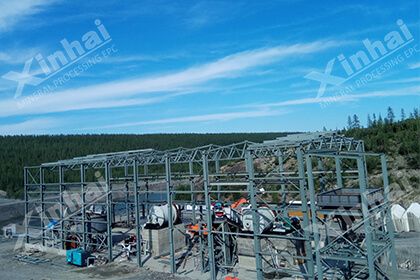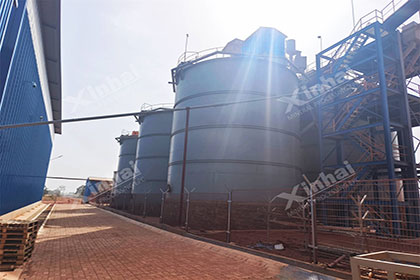Cu-Pb Froth Flotation Guidance
 Sharon
Sharon
 May 24, 2022
May 24, 2022
 1432
1432
If you want to know more details about equipment, solutions, etc, please click the button below for free consultation, or leave your requirements!

Froth flotation is a beneficiation process that is based on the difference in physical and chemical properties of the mineral surface. The froth flotation process is mainly used to separate non-ferrous metals such as copper, lead, zinc, nickel, gold, etc. In addition, froth flotation is suitable for the separation of fine particles that are difficult to recover by other beneficiation methods. Copper-lead ore has the characteristics of fine particle size and dense symbiosis of useful minerals, therefore, froth flotation is mainly used for the recovery of copper-lead ore at home and abroad.
This article will introduce the froth flotation of copper-lead ore from the following three aspects.
Copper-lead flotation inhibition separation method
Copper-lead flotation process
Copper-lead flotation reagent system
Let's drive in!
01 Copper-Lead Flotation Inhibition Separation Method
Back(1) Solution to Inhibiting Separation of Copper and Lead
There are generally two solutions to separation of copper and lead, one is float copper and repress lead, and the other is float lead and repress copper. The separation method is shown in Table 1.

The copper-lead inhibition separation methods listed in Table 1 can be summarized into three methods: cyanide method, dichromate method and sulfurous acid method.
① Cyanide has a strong inhibitory effect on chalcopyrite but almost no inhibitory effect on galena, so cyanide can be used to float lead and repress copper.
② Dichromate is the most important inhibitor of galena, while it has no effect on the flotation of copper minerals, therefore it often used to separate copper and lead mixed concentrates.
③ Sulfur dioxide is not only a good inhibitor of lead also inhibitor of sphalerite and pyrite under certain conditions, and has an activating effect on copper minerals. Sulfurous acid can also be used with sodium sulfide or starch to suppress lead and float copper, which is conducive to improve the separation effect and stability.
(2) Principles of Selecting Copper-Lead Flotation Method
The flotation method of copper-lead ore can be selected from the following aspects:
① Mineral Composition
The main basis for selecting the separation method is the mineral composition in the copper-lead mixed concentrate. For example, galena whose surface is oxidized and not activated by Cu2+ is easily inhibited by dichromate and sulfurous acid. Galena activated by Cu2+ can be used with sulfurous acid and sodium sulfide or sodium thiosulfate and ferrous sulfate (or ferric chloride) to suppress lead and float copper.
② Copper to Lead Ratio in Mixed Concentrate
The general separation principle is to suppress the minerals with high content in the copper-lead mixed concentrate, and float the minerals with less content in the copper-lead mixed concentrate, so as to reduce the inclusion of foam products and obtain better separation result.
③ The Content of Rare Metals and Precious Metals
In the case of high content of rare metals and precious metals in the copper-lead ore, the rare and precious metals should be concentrated in the concentrate as much as possible. To prevent the loss of gold and silver from dissolution, it is recommended to avoid using the cyanide method.
02 Froth Flotation Separation Process of Copper-Lead Ore
BackAt present, the froth flotation separation process of copper and lead ore mainly includes: preferential flotation ; mixed flotation tailings-mixed concentrate priority flotation separation process; iso-flotation.
(1) Preferential Flotation
The priority flotation process is based on the flotability of the copper and lead minerals in the ore, and then adopts a targeted reagent system to separate the copper and lead from the ore slurry in order to obtain separate concentrates and tailings.
The advantage of preferential flotation is that the operation process is easy to control and it is easy to get qualified concentrates. This process is characterized by taking advantage of the dissemination characteristics of useful minerals in the ore, while combining selective collectors and selective inhibitors, to achieve the separation of copper and lead minerals in priority flotation.
(2) Bulk Flotation Tailing Discarding -Mixed Concentrate Priority Flotation Separation Process
Bulk flotation tailing discarding -mixed concentrate priority flotation separation process is to select all sulfide minerals into the mixed concentrate to obtain two products, the mixed concentrate and the discarded tailings, and then carry out the copper-lead separation after the mixed concentrate is demedicated. This process has the advantages of saving grinding costs, reducing flotation cell wear and flotation reagent consumption.
(3) Iso-Flotation
Iso-flotation is a process in which useful minerals with similar flotation properties are concentrated in a copper-lead mixed concentrate,and then separate the mixed concentrate by froth flotation. This process has the advantages of bulk flotation and priority flotation process. The froth flotation separation is based on the flotation difficulty of useful minerals, which can save the dosage of chemicals, but the flotation operation takes a long time and the process operation is complicated.
03 Reagent System for Flotation Separation of Copper and Lead
BackIn order to maintain an optimal concentration of flotation reagent in the slurry, the flotation reagent must be dosed properly. A good reagent system can give full play to the reagent performance. Reasonable dosing sequence, dosing place and dosing method should be chosen according to the ore characteristics, reagent performance and process requirements.
(1) Dosing Sequence
The dosing sequence of flotation reagents for copper-lead ore is generally PH adjuster-activator or inhibitor-collector- frother.
(2) Dosing Place
The dosing location is determined by the nature of the agent and the required reaction time. PH conditioners and inhibitors are mostly added in the ball mill; diffluent collectors, activators and frothers are usually added in the agitation tank before flotation.
(3) Dosing Method
Dosing methods include centralized dosing and batch dosing. The former is added all the flotation reagent to the slurry all at one time, and the concentration of the reagent is high at a certain position, which makes the reagent highly effective and improves the speed at the early stage of froth flotation. The latter is added point by point or in batches to maintain a uniform concentration throughout the froth flotation process, which helps to improve the selectivity and recovery of difficult-to-flotation materials.
04To Wrap Up
BackThis article introduces copper-lead flotation related knowledge from three aspects: copper-lead flotation inhibition separation method, copper-lead flotation process, copper-lead flotation reagent system. Choosing the suitable flotation process can not only improve the concentrate grade, but also promote the normal operation of the entire concentrator. For the flotation plant, the right choice of the flotation process is very important. It is recommended that all mine owners carefully analyze the actual situation and determine the equipment and process suitable for their own by consulting the manufacturers with the overall qualification of the plant to avoid unnecessary economic losses.
If you have other opinions or questions about the above content, or want to purchase processing equipment, you can consult our online customer service or leave a message, we will contact you ASAP.
 +86 18716000713
+86 18716000713 xlyin@xinhaimining.net
xlyin@xinhaimining.net




 Message
Message Chat Now
Chat Now

















